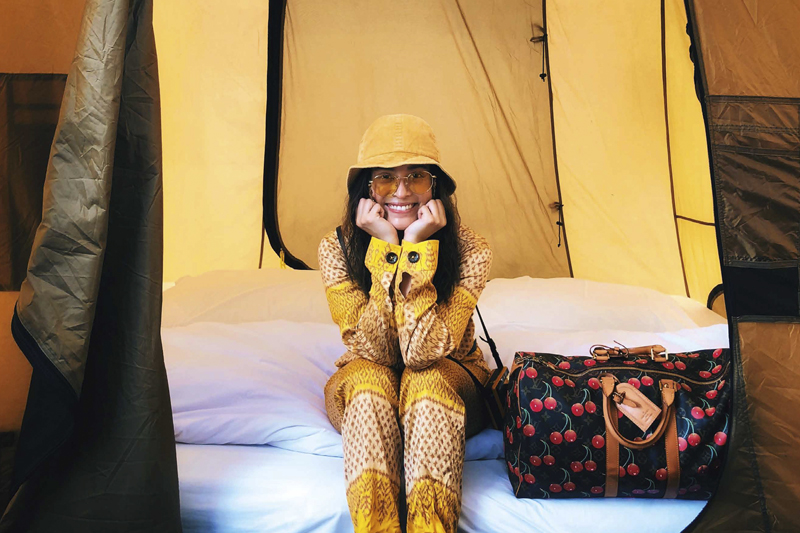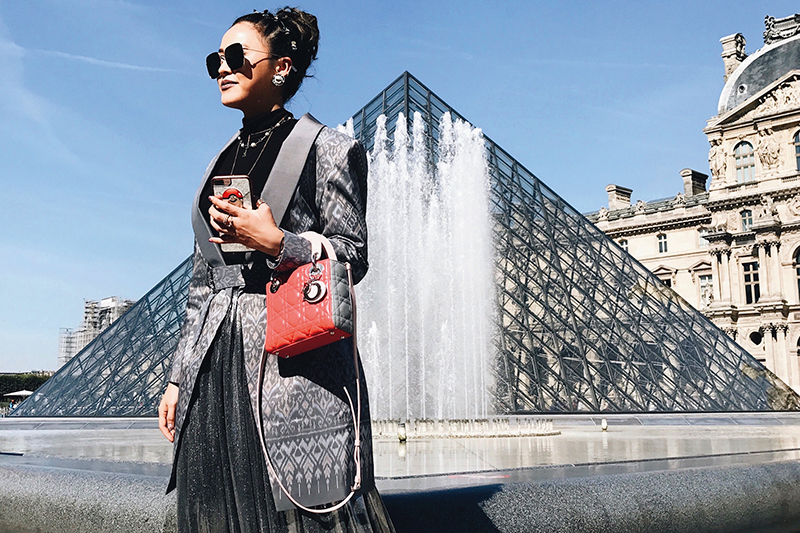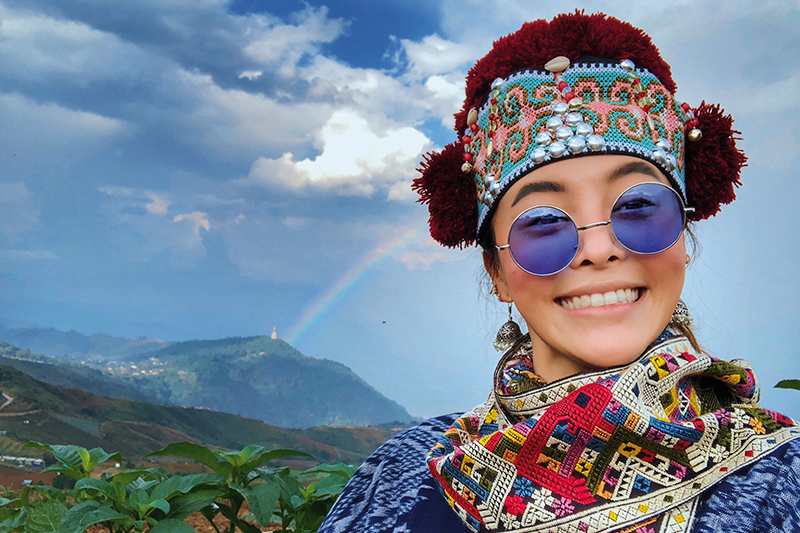
Meet Pearypie: An Influencer Moves from Cosmetics to Traditional Wear
Makeup tutorials shot her to fame, and now this Instagram star hopes that by adding the cool factor to Thai traditional fabrics, they get to develop their own fandom.
Words Phoowadon Duangmee
Photos Amata Chittasenee, Wichit Kongsiangsung
On one Monday afternoon, Amata Chittasenee made her way to a Thai restaurant in Thong Lor, Bangkok’s trendy and fashionable neighbourhood. Her face, in neat makeup, had a sweet and charming glow. An outfit of a loose shirt and trousers from Thai traditional fabric may contrast with her Dr. Martens but they definitely made a fashion statement. In making Thai silk and combat boots unusual bedfellows, she made it cool. Her real name, Amata, makes her a relative unknown. But it’s “Pearypie” – her social media persona – that gives her celebrity status with almost two million followers in Asia and beyond.
“That’s Pha Lai Yang! What a coincidence!” Amata or Pearypie bursts in excitement, as she discovered a piece of fabric hanging down a wooden bar at Patara Fine Thai Cuisine. It turns out her outfit and textiles in the restaurant are made from traditional Pha Lai Yang (Siamese chintz), which was once reserved for aristocracy in the late Ayutthaya and early Rattanakosin period and whose decorative patterns denote rank.
“This traditional textile has a long history, when the trend of printed fabric made its way for the very first time to the Ayutthaya kingdom. Back then, Siam didn’t have the technology for printed fabric, and artisans in the royal court had to design the floral patterns before sending them to be printed in a textile factory in India,” she says.
Concluding her story about India-Siam fashion influence around the 18th century, she called a waitress to order a glass of iced coffee to treat herself on a warm afternoon as I took notes on her commitment to traditional Thai fabrics.
Amata’s friendly smile makes her seem quite nice and her story also holds amazing twists and turns.

Born into a well-off family in Bangkok, Amata went to Central Saint Martin’s in London, England, to study art and theatrical design. Then she earned a master’s degree in business management. Like many people in the digital age, Amata has her physical world interface with a digital realm. She created “Pearypie” as an online identity to enjoy the thrill and adventure in digital platforms via Instagram, Facbook and other social media applications. Driven by a passion for makeup and fashion, she started her Instagram feed sharing makeup tutorials.
“I am passionate about makeup, and always take it as an art form,” said Amata, having done her visual arts degree in the London art school. “I painted and dabbed in colours and cosmetics on models’ faces. When the models changed their postures or express different emotions, I could see my art, as makeup springs to life and develops into different perspectives.
“When you do what you love, you give it your very best. I take Instagram, Facebook and other digital platforms as my centre stage, to bridge my creativity with like-minded followers.” Recently, Pearypie has 1.6 million followers. In the past five years, she was recognised as a leading beauty and fashion influencer in Asia. The viral success took her to London and Paris fashion shows. She worked with some major brands and had significant collaborations.
Pearypie had been happy with the challenge and success for five years until she found a drawback in the circle of online influencer and shill business of product endorsement.
By nature, an online influencer is a creature of propaganda. Unlike TV commercials in the conservative form of advertisement, the authenticity that drives the world of online advertising is based on having ordinary people recommend merchandise or services they enjoy. Imagine a review from some real user or even your friends telling the high and low points of their latest smartphone, digital camera or a new restaurant in the neighbourhood based on their liking. You don’t need very much creativity to shill a product, but you have to make your feed raw and real to ensure that people will respond to your post.
But Pearypie is not the average influencer. “As soon as I post my latest beauty clip in my channels, someone would make a comment immediately: I cannot wait for your next video clip,” said Pearypie. “That’s heartbreaking! It took me longer than a month to do a storyboard, shooting, editing, reediting and finalising a video clip. Alas, the emotions and the lifespan of the clip lasted only a few seconds. Did a follower really appreciate my creativity?

Clearly, Amata, while an affable person, is also frank. She has many stories to share and is not shy to express her feelings and ideas. Looking into her dark eyes, I could see a strong sense of independence and willfulness. The fashion industry is full of untruths, Amata admitted, and a person around the industry sometimes insults human intelligence by talking and dramatising the same old things.
Almost two million people follow you, and many of them see you as an influencer, who is your influencer or I do, I asked – wondering if an influencer needs an influencer? “My influencers are Samruay in Buri Ram province, Ko in Surin province, Kong at The Cloud who is an environmental crusader and Kob at Big Tree Foundation who is a guardian of every single tree in the city,” says Amata. “My influencers and idols are ordinary people, a common man and woman, who contribute extraordinary work to a community.”
Pearypie gave me a full body twist, and I needed a high dose of caffeine to handle her spin. In this case, a double shot espresso would do.
If you follow Pearypie’s IG feed or Facebook lately, you might realise that Pearypie does not feed beauty video clips any more. She found a new thrill in traditional Thai fabrics. This beauty influencer has transformed herself into a fashionista. While many Thais find their traditional and ethnic textile uninspiring, Pearypie finds them cool and chic.
“I got a piece of silk a few years ago as a gift for my beauty workshop at Khon Kaen University. The lecturer kept telling me how expensive and luxurious Khon Kaen silk was, and I doubted it, maybe it was an overstatement,” recalled Pearypie. With no better idea of what to do with that piece of silk, Pearypie tailored her clothing and packed it for a Dior fashion show in Paris. It was silk, burgundy-pink with geometric patterns, a classic blouse with Mandarin collar, winged shoulders and long sleeves. Pearypie put it on with her denim jeans to make a statement for Khon Kaen silk in Paris.
“People from Dior gave me a thumbs up, and they asked where I got such a beautiful fabric to make my blouse,” said Pearypie. “Wow! Our traditional textiles can be super cool and extremely good if we make it right.”
After a trip to Paris, Pearypie gravitated to a new passion – traditional Thai fabrics. She often travels across the country scouring for material for her custom-made designs. Following the threads of textiles to local looms around Thailand, Pearypie came across equally beautiful people in her eyes who have dedicated their craftsmanship for the sustainable and lasting beauty of Thai fabrics.
“In Buri Ram province, I met Auntie Samruay, who took me to gather volcanic stone in the wood, and she even taught me about sustainability. In Udon Thaini, I found out that local people dye their clothes using water lily flowers,” said Pearypie. “As a makeup artist, I deal with colours and pigments all the time – but they’re chemicals. The local people taught me to source pigments from nature. They really took me out of my comfort zone. They’re my influencers.”
Pearypie demystifies the “traditional textile makes boring dress” idea with her stylish designs that fit into the modern lifestyle. She wore her custom-made outfits and took some photos at iconic landmarks and travel destinations, such as Petra caves in Jordan, the Pink Palace in India’s Jaipur and the Louvre Museum in Paris.
Pearypie posted her photos with these outfits in her social media networks, and followers take their hats off to her for the creativity.
“I want to create a new fashion for traditional Thai fabric. I want to make it cool,” she ended.
Special thanks to Patara Fine Thai Cuisine for shooting location. patarathailand.com, +66 (0) 2185 2960-1

เมื่ออมตา จิตตะเสนีย์ ก้าวเข้ามายังร้านอาหารภัทรา ย่านทองหล่อ ร้านก็ดูสว่างจากออร่าของเธอขึ้นทันตา ใบหน้าสวยหวานแต่งแต้มด้วยเครื่องสำอางอย่างพิถีพิถัน เสื้อผ้าไทยหลวมๆ และกางเกงขายาวดูขัดกับรองเท้า Dr. Martens ทว่าลงตัว น้อยคนนักที่จะรู้จักเธอในนาม “อมตา” แต่ถ้าเรียกเธอว่า “แพรี่พาย” แล้วไม่ได้ยินเสียง “อ๋อ” คงแปลกน่าดู
บังเอิญที่ผ้าแขวนประดับร้านอาหารกับผ้าที่ใช้ตัดเสื้อของเธอคือผ้าไทยดั้งเดิมชนิดเดียวกัน ยิ่งสร้างความตื่นเต้นขึ้นไปอีก คุณอมตาเล่าถึงความเป็นมาของผ้า “ลายอย่าง” ด้วยความตื่นเต้นว่าเป็นผ้าสำหรับชนชั้นสูงในสมัยอยุธยาและรัตนโกสินทร์ตอนต้นเท่านั้น ในสมัยอยุธยาเทคโนโลยีในการพิมพ์ลายผ้ายังไม่พัฒนามากพอ ช่างหลวงจึงจำเป็นต้องส่งลายผ้าให้โรงงานพิมพ์ผ้าที่อินเดียผลิตให้เลยทีเดียว พอเราได้ฟังเรื่องที่เธอเล่า เห็นทีเธอคงไม่ใช่เน็ตไอดอลธรรมดาๆ แน่ๆ
ภายใต้รอยยิ้มหวานเป็นมิตร มีเรื่องราวชีวิตที่ไม่คาดคิดแฝงอยู่ อมตาเกิดและโตในกรุงเทพฯ เธอเข้าศึกษาการออกแบบศิลปะและละครใน Central Saint Martin’s กรุงลอนดอน จากนั้นเรียนจบปริญญาโท สาขาบริหารธุรกิจ เธอได้สร้างตัวตนในนาม “แพรี่พาย” บนโลกดิจิทัลออนไลน์ผ่านอินสตาแกรม เฟสบุ๊ค และโซเชียลมีเดียอีนๆ เธอเริ่มจากการสอนแต่งหน้าด้วยความหลงใหลในเครื่องสำอาง
เธอเล่าว่า การแต่งหน้าคือศิลปะรูปแบบหนึ่ง สีสันบนใบหน้าของนางแบบขณะเปลี่ยนท่วงท่าแสดงให้เห็นถึงศิลปะที่พัฒนาเป็นมุมมองที่แตกต่างออกไป เธอย้ำว่า คนเราจะทำอะไรเต็มที่เมื่อสิ่งนั้นเป็นสิ่งที่เรารัก และโลกออนไลน์ก็เป็นเหมือนสะพานที่เชื่อมระหว่างความคิดสร้างสรรค์ของเธอกับผู้ติดตามที่มีความหลงใหลในสิ่งเดียวกัน
ปัจจุบัน แพรี่พายมียอดผู้ติดตามกว่า 1.6 ล้านคน เธอได้รับการยอมรับในเอเชียว่าเป็นกูรูด้านความงามและแฟชั่น จนนำมาซึ่งความสำเร็จในงานแฟชั่นโชว์ระดับโลก ณ กรุงลอนดอน และปารีส
ตลอดห้าปีในฐานะแพรี่พาย เธอมีความสุขกับความท้าทายและความสำเร็จ แต่วงการออนไลน์อินฟลูเอ็นเซอร์และการรีวิวสินค้าออนไลน์ไม่ได้น่าตื่นเต้นสำหรับเธออีกต่อไป
เธอเล่าว่า พอเธอโพสต์คลิปวีดีโอล่าสุด ก็จะมีคนมาคอมเม้นต์ว่า “รอคลิปต่อไปอยู่นะคะ” แต่ใครจะรู้ว่า กว่าเธอจะสร้างสตอรี่บอร์ด ถ่ายทำ และตัดต่อ กระบวนการทั้งหมดนั่นใช้เวลาเป็นเดือน ขณะที่ความรู้สึกและอายุของคลิปวีดีโอมีความยาวแค่ไม่กี่วินาที จนเธอเกิดคำถามในใจว่า ผู้ที่ติดตามเธอเห็นคุณค่าของความคิดสร้างสรรค์จริงหรือเปล่า
นัยน์ตาสีเข้มของอมตาสะท้อนความเป็นตัวของตัวเองและความมุ่งมั่น แล้วเราก็ได้แปลกใจอีกครั้งเมื่อได้รู้ว่าไอดอลของแพรี่พายคือใคร
คุณอมตาได้รับแรงบันดาลใจจากคุณสำรวยที่บุรีรัมย์ คุณโก้ที่สุรินทร์ คุณก้องที่ The Cloud และคุณกบที่ Big Tree Foundation เธอบอกกับเราว่า แรงบันดาลใจของเธอมาจากคนธรรมดานี่แหละ บุคคลเหล่านี้คือผู้ที่สร้างคุณูปการให้แก่สังคมของเรา
หากคุณติดตามแพรี่พายผ่านไอจีและเฟสบุ๊ค จะสังเกตว่าเธอหันมาให้ความสนใจผ้าไทยโบราณ เปลี่ยนตัวเองให้เป็นแฟชั่นนิสต้าผ้าไทย เธอเล่าว่า เธอได้รับผ้าไหมจากมหาวิทยาลัยขอนแก่น เธอตัดผ้าไหมสีชมพูเบอร์กันดีลายเรขาคณิตผืนหนึ่งเป็นเสื้อแขนยาวคอจีนไหล่ตั้งเล็กน้อย สวมคู่กับกางเกงยีนส์ ชุดของเธอสวยงามจนดีไซเนอร์ดิออร์ยกนิ้วให้ในงานแฟชั่นโชว์ที่ปารีส
กลับจากปารีส แพรี่พายได้ค้นพบความตื่นเต้นใหม่ในผ้าไทยโบราณ เธอเดินทางไปทั่วประเทศเพื่อเฟ้นหาลายผ้าที่เปี่ยมด้วยเอกลักษณ์จนเธอได้พบกับผู้คนมากมายที่อุทิศตนเพื่อสืบสานงานฝีมืออันงดงามของไทยไว้
อมตาได้ความรู้มากมายจากชาวบ้าน ไม่ว่าจะเป็นการใช้สีย้อมผ้าจากดอกบัวและอีกหลายๆ ศาสตร์จากธรรมชาติ เธอพบโลกแห่งภูมิปัญญาและความพอเพียง โลกใบใหม่นี้เองที่สร้างให้งานศิลปะของเธอมีเอกลักษณ์ ผ้าไทยจึงไม่ใช่เรื่องน่าเบื่ออีกต่อไป อมตาสวมใส่เสื้อผ้าตัดจากผ้าทอผ้าไทย โดยมีภาพพื้นหลังเป็นถ้ำเพตราในจอร์แดน พระราชวังสีชมพูในอินเดีย หรือจะเป็นพิพิธภัณฑ์ลูฟว์ในปารีส
แพรี่พายแบ่งปันความแปลกใหม่สร้างจากความดั้งเดิมของไทย ผนวกผ้าไทยเข้ากับไลฟ์สไตล์สมัยใหม่ของแต่ละคน เปลี่ยนความคิดว่า ผ้าไทย “เชย” ให้เป็นความ “ชิค” แบบลงตัว
